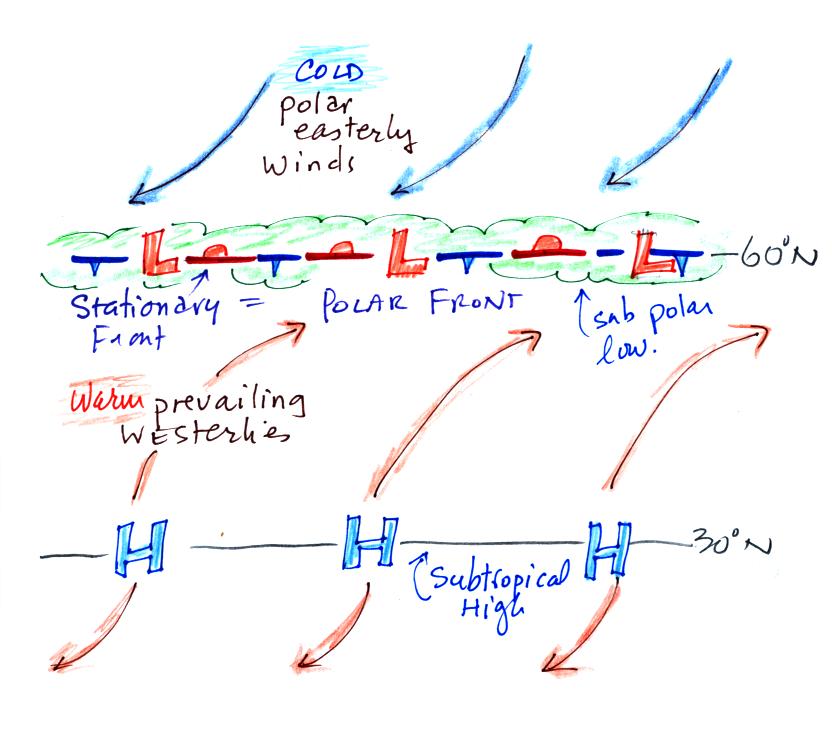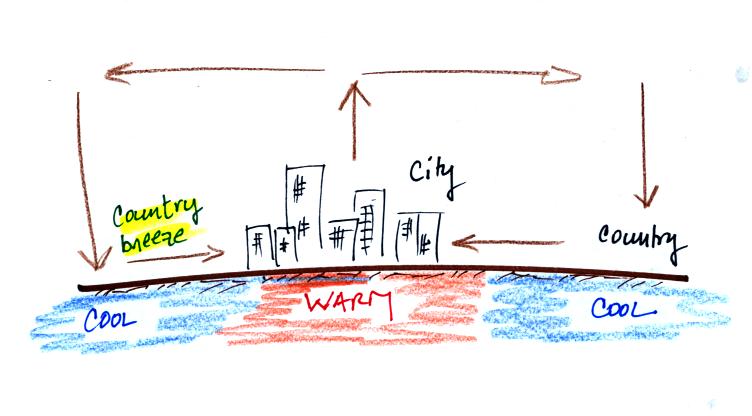
Cities are often warmer than the
surrounding
countryside,
especially at night. This is referred to as the urban heat island
effect. This difference in temperature can create a
"country breeze."
The Asian monsoon (monsoon refers to a seasonal change
in the direction of the prevailing winds) is a large scale circulation
pattern and is much more complex than a simple thermal
circulation. However you can
use the thermal circulation concept to get a general understanding of
what to expect at different times of the year.

In the summer India and SE Asia
become warmer than the
oceans
nearby. Surface low pressure forms over the land, moist winds
blow from the ocean onshore, and very large amounts of rain can
follow. The view above at left is from above, the view at right
is from the side.
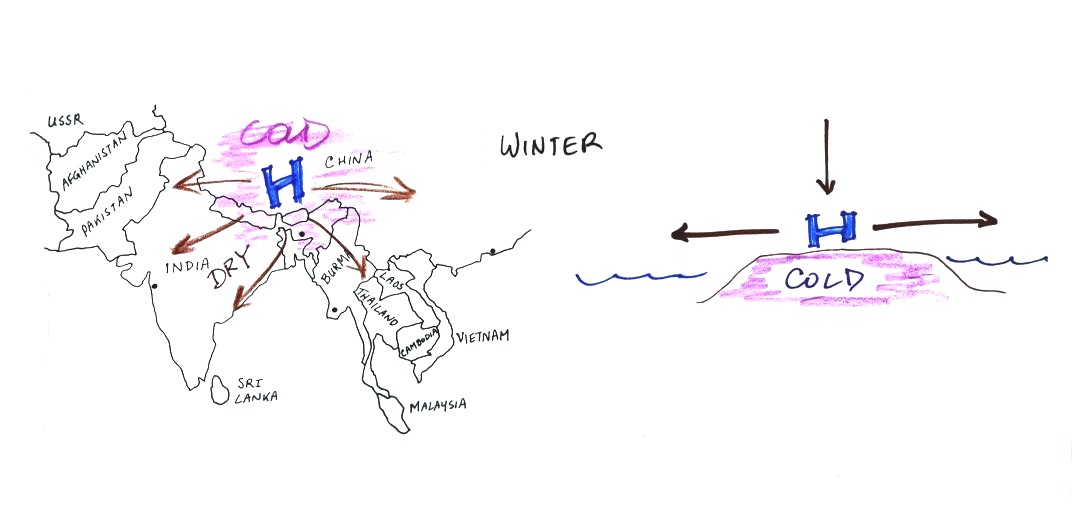
The winds change directions in the
winter when the
land becomes colder
than the ocean.
You can
also use the thermal circulation to understand some of the basic
features of the El Nino phenomenon (you find a discussion of the El
Nino on pps 135-139 in the photocopied Classnotes).
First here is what conditions look like in the tropical Pacific Ocean
in non-El Nino years (top and side views again)

Cold ocean currents
along the west coasts of N. America and S.
American normally converge at the equator and begin to flow westward
(see top view above). As the water travels westward it
warms. Some of the warmest sea surface waters on the earth are
normally found
the western Tropical Pacific. A temperature gradient becomes
established between the W. and E. ends of the tropical Pacific. The
crossectional view above shows the normal temperature and circulation
pattern found in the equatorial Pacific Ocean. You would
find surface high pressure in the east and low pressure in the
west. Note that the wind circulation pattern is the same as the
simple thermal circulation we studied above.
Every few years El Nino conditions occur and the cold currents don't
make it to the
Equator. Warm water is carried from the western Pacific to the
eastern Pacific

Now surface high
pressure is found in the west and surface low
pressure and rising air is found in the E. Pacific (the reversal in the
surface pressure pattern is referred to as the southern
oscillation). Indonesia and Australia often experience drought
conditions during El Nino events. In the desert SW we expect
slightly wetter than normal conditions (perhaps 20% wetter than
normal). Wetter conditions are also found in California and in
the SE US.
OK here's what we spent most of the class period on.
We'll use
the thermal circulation idea
to learn
something about global scale pressure and wind patterns on the
earth. Ordinarily you couldn't apply a small scale phenomena like
a thermal circulation to the much larger global scale. However if
we make some simplifying assumptions, particularly if we assume that
the earth doesn't rotate or only rotates slowly, we can ignore the
Coriolis force.
Some additional simplifications are also made and are listed below (p.
133 in the photocopied Classnotes)
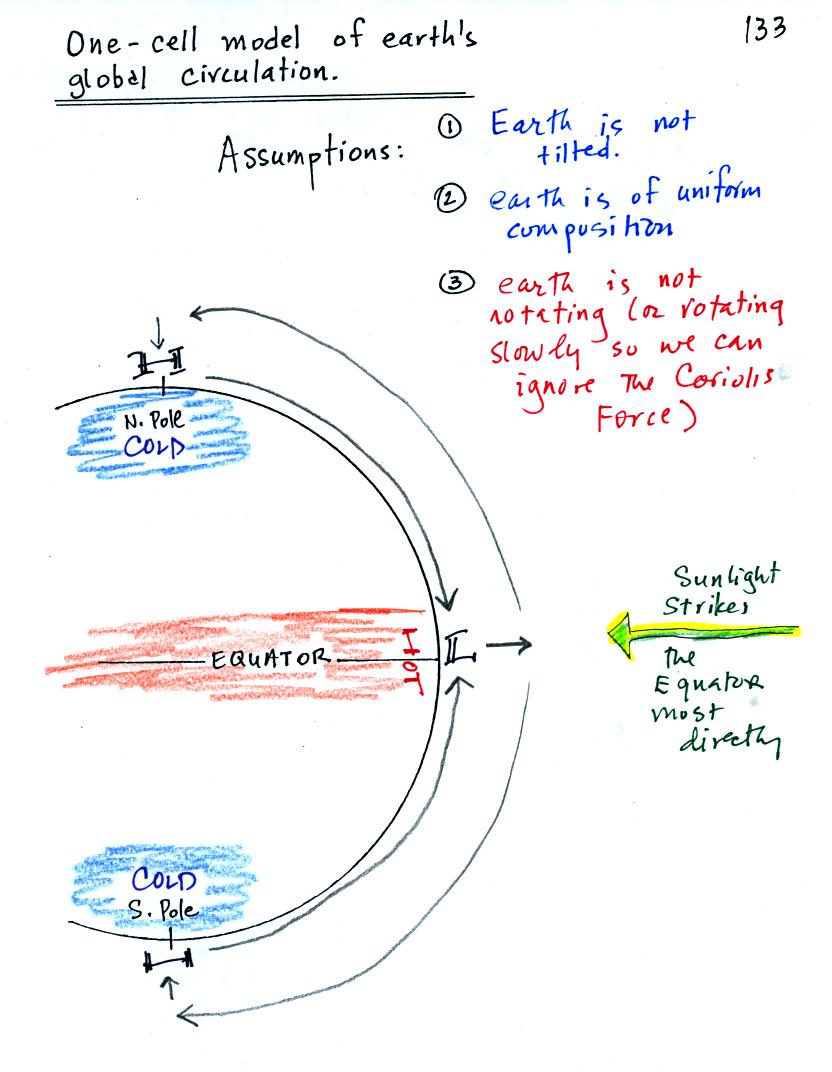
Because the earth isn't tilted, the incoming sunlight
shines
on the earth most directly at
the
equator. The equator will become hotter than the poles. By
allowing the earth to rotate slowly we spread this warmth out in a belt
that circles the globe at the equator rather than concentrating it in a
spot on
the side of the earth facing the sun. Because the
earth is of uniform composition there aren't any temperature
differences created between oceans and continents.
You can see the wind
circulation pattern that would develop. The term one cell
just means there is one complete
loop
in the northern hemisphere and another in the southern hemisphere.
Next we will remove the assumption concerning the rotation of the
earth. We won't be able to ignore the Coriolis force now.
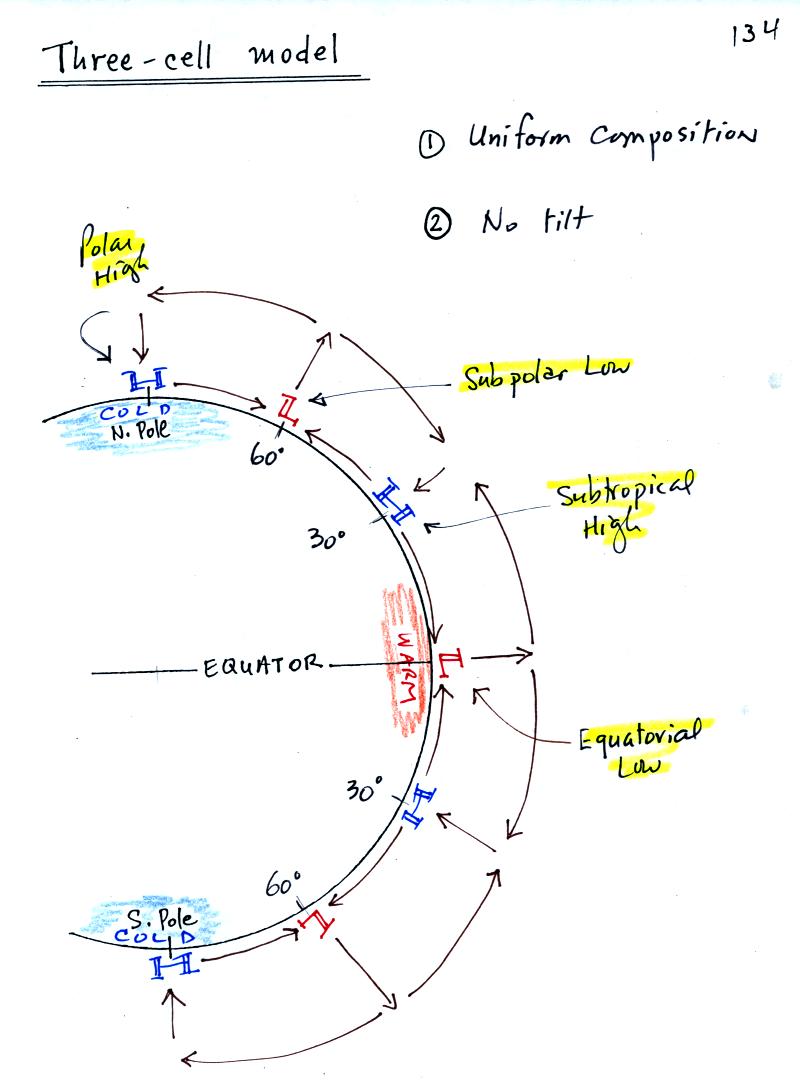
Here's what a computer would predict you would now see on
the earth. Things are pretty much the same at the equator in the
three cell and one cell models: surface low pressure and rising
air. At
upper levels the winds begin to blow from the equator toward the
poles. Once headed toward the poles the upper
level winds are deflected by the Coriolis force.
There end up being three closed loops in the northern and in the
southern hemispheres. There are surface belts of low
pressure
at the equator (the equatorial low)
and at 60 degrees latitude (the subpolar
low). There are belts of high pressure (the subtropical high) at 30
latitude and high pressure centers at the two poles (the polar highs).
We will look at the surface features in a little more detail because
some of what is predicted, even with the unrealistic assumptions, is
actually found on the earth.
We'll first look at surface pressures and winds on the earth from 30 S
to 30 N, the tropics and subtropics.
Then we'll look at the region from 30 N to 60 N, middle
latitudes, where most of the
US is located. The figure below was redrawn after class.
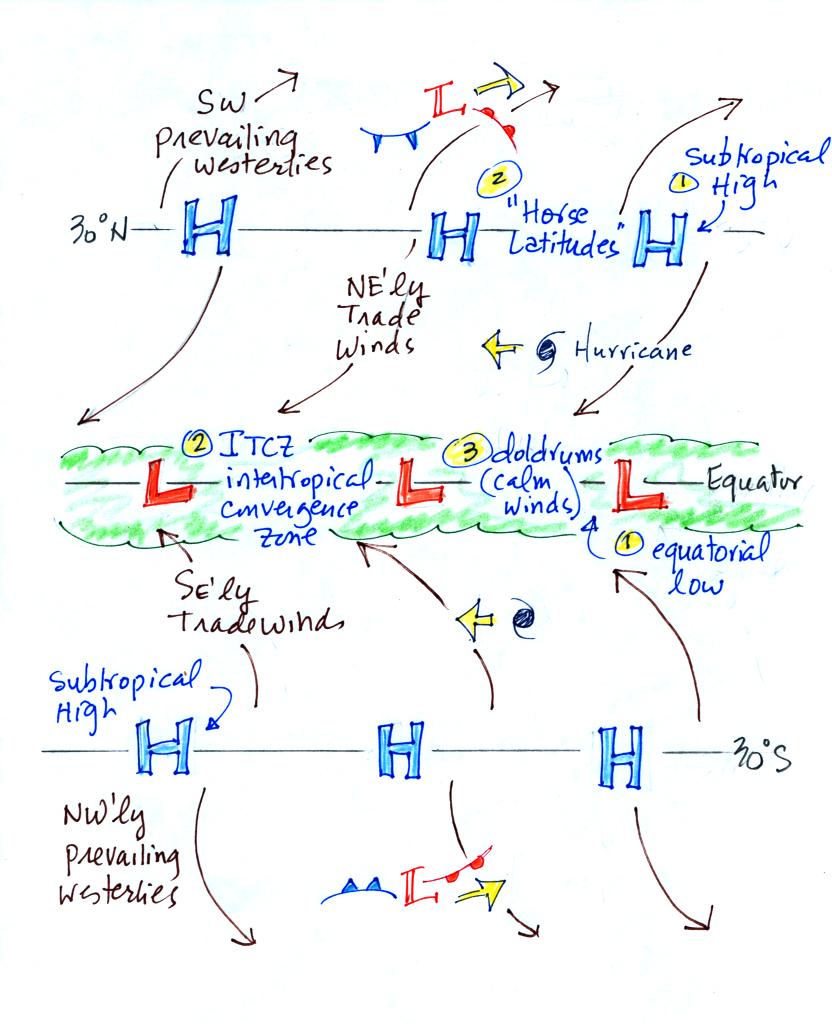
With a little study you should be able to start with a
blank
sheet of paper and reproduce this figure. I would suggest
starting at the equator. You need to remember that there is a
belt of
low pressure found there. Then remember that the pressure belts
alternate: there are belts of high pressure at 30 N and 30 S.
Let's start at 30 S.
Winds will begin to
blow from High pressure at 30 S toward Low pressure at the
equator. Once the winds start to blow they will turn to the left
because of the Coriolis force. Winds blow from 30 N toward the
equator and turn to the right in the northern hemisphere (you need to
turn the page upside down and look in the direction the winds are
blowing). These are the Trade
Winds (northeasterly trade winds north of the equator and
southeasterly trades south of the equator). They converge at the
equator and the air there rises (refer back to the crossectional view
of the 3-cell model). This is the cause of the band of clouds that you
can often see at or near the equator on a satellite photograph.
The Intertropical Convergence Zone or ITCZ is another name for the
equatorial low pressure belt. This region is
also referred to as the doldrums because it is a region where surface
winds are often weak. Sailing ships would sometimes get stranded
there hundreds of miles from land. Fortunately
it is a cloudy and
rainy region so the sailors wouldn't run out of drinking water.
Hurricanes form over warm ocean water in the subtropics between the
equator and 30
latitude. Winds at these latitudes have a strong easterly
component and hurricanes, at least early in their development, move
from east to west. Middle latitude storms found between 30 and 60
latitude, where the prevailing westerly
wind belt is found, move from
west to east.
You find sinking air, clear skies, and weak surface winds associated
with the subtropical high pressure belt. This is also known as
the horse latitudes. Sailing ships could become stranded there
also. Horses were apparently either thrown overboard (to conserve
drinking water) or eaten if food supplies were running low. Note
that sinking air is associated with the subtropical high pressure belt
so this is a region on the earth where skies are
clear (Tucson is
located at 32 N latitude, so we are affected by the subtropical high
pressure belt).
The winds to the north of 30 N and to the south of 30 S are called the
"prevailing westerlies."
They blow from the SW in the northern hemisphere and from the NW in the
southern hemisphere. The 30 S to 60 S latitude belt in the southern
hemisphere is mostly ocean. Because there is less friction over
the oceans, the prevailing westerlies there can
get strong, especially in the winter. They are sometimes referred
to as the "roaring 40s" or the "ferocious 50s" (the 40s and 50s refer
to the latitude belt they are found in).
Here's the other map, it's a little simpler. Winds
blowing north from H
pressure at 30 N toward Low pressure at 60 N turn to the right and blow
from the SW. These are the "prevailing westerlies."
The polar easterlies are cold winds coming down from high pressure at
the north pole. The subpolar low pressure belt is found at 60
latitude. This
is also a convergence zone where the cold polar easterly winds and the
warmer prevailing westerly winds meet. The boundary between these
two different kinds of air is called the polar front and is often drawn
as a stationary front on weather maps. A strong current of winds
called the polar jet stream is found overhead. Strong middle
latitude storms will often form along the polar front.
The 3-cell model predicts subtropical belts of high
pressure near
30
latitude. What we really find are large circular centers of high
pressure. In the northern hemisphere the Bermuda high is found
off the east coast of the US, the Pacific
high is positioned
off the
west coast. High pressure centers are found east and west of
South America in the southern hemisphere.
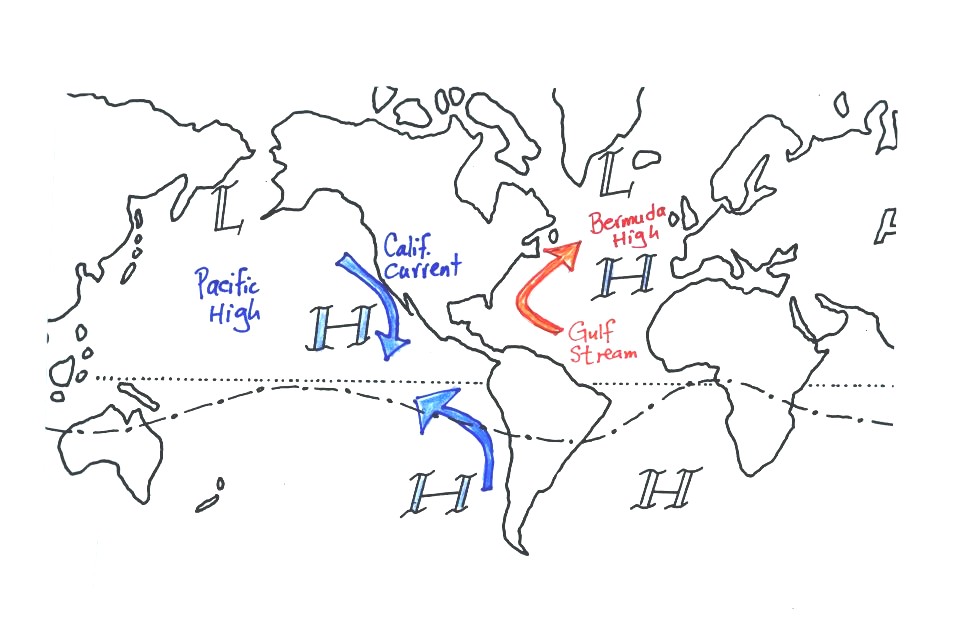
The winds that blow around these large scale high pressure
centers create some of the major ocean currents of the world. If
you
remember that high pressure is positioned off the east and west coast
of the US, and that winds blow clockwise around high in the northern
hemisphere, you can determine the directions of the ocean currents
flowing off the east and west coasts of the US. The Gulf Stream
is a warm current that flows from south to north along the east coast,
the California current flows from north to south along the west coast
and is a cold current. A cold current is also found along the
west coast of South America; winds blow counterclockwise around
high in
the southern hemisphere. These currents are shown in the picture above (not shown in class).
Circular low pressure centers, the Icelandic low (off the east coast
near Iceland and Greenland in the picture below) and
the Aleutian low (off the west coast near the southern tip of Alaska),
are found near 60 N.
The cause
of the summer monsoon in Arizona was discussed briefly (and not very
well) in class. Hopefully the more carefully drawn pictures below
will make this a lot clearer.

Tucson gets about 12 inches of rain
in a normal year (we are well below
normal this year). About half of this comes during
the "summer monsoon" season. The word monsoon, again, refers to a
seasonal change in wind direction. During the summer subtropical
high pressure (the Pacific high) moves north of its normal position
near 30 N
latitude. Winds on the southhern side of the subtropical high
have an easterly component. Moist air originating in Mexico
and the Gulf of Mexico blows into Arizona. The sun heats the
ground during the day, warm moist air in contact with the ground rises
and
produces convective thunderstorms.
The close proximity of the Pacific high, with its sinking air motions,
is what gives California, Oregon, and Washington dry summers.
In the winter the subtropical high moves south of 30 N latitude.
Winds to the north of the high blow from the west. Air
originating over the Pacific Ocean loses much of its moisture as it
crosses mountains in California (remember the rain shadow
effect). The air is pretty dry by the time it reaches
Arizona. Significant winter rains occur in Arizona when storms
systems are able to draw moist subtropical air from the southwest into
Arizona.











